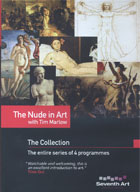
The Nude in Art with Tim Marlow 2010
Distributed by Microcinema International/Microcinema DVD, 2169 Folsom Street, Suite M101, San Francisco, CA 94110; 415-447-9750
Produced by Seventh Art Productions
Directed by Phil Grabsky
DVD, color, 100 min.
College - Adult
Art, Art History
Date Entered: 04/14/2011
Reviewed by Jane Scott, Public Services Librarian, George Fox UniversityTim Marlow, world renowned British Art Historian, narrates this four-part series about the nude in art and its ongoing significance. Using Classical, Renaissance, Enlightenment, and Modern representative masterpiece nudes, Marlow imparts information about each piece’s societal context. Marlow suggests the nude depicts man’s understanding of himself, his world, his culture, and his relationship to his God/Gods and therefore is the most enduring image in art. Intermittently, Marlow is joined by three art intellectuals: art historian Peter Webb (author of The Erotic Arts), historian Christopher Kelly (Cambridge University), and journalist David Waters (Men’s Health Magazine).
The Classical segment begins with a look at the famous prehistoric nude figurine of Venus of Willendorf, and touches briefly on the Egyptian culture’s portrayal of the nude. Most of the focus, however, is on pieces of Greek and Roman sculpture accentuating the power and military prowess of each culture and the classical idealized form of the human body seen also in the representations of the gods and goddesses.
The Renaissance begins with the rise of Christianity and the church’s influence on the depiction of the nude human form. Nudity, according to Marlow, becomes associated with sin and is depicted as such until the 15th century when the works of Brunelleschi, Donatello, Verrocchio, de Vince, and Michelangelo begin to redefine man’s beauty, power, and relationship to his God.
The Enlightenment begins in the late 17th century when major works of art were still commissioned by the church and the aristocracy. The church was combating the reformation and the aristocracy was combating the rising desire of citizens for a voice in their own governance. Thus, the nude is used to question the status quo in a number of different ways. Marlow shows the work of Delacroix, Courbet, and Gericault to illustrate this point.
The modern era beginning roughly in the 19th century struggled with the challenge of photography. The nude was now available to the masses and many of the “isms” such as impressionism, cubism, and Dadaism were experimental responses to this new photographic technology providing an unchallenged realism. Here we see Picasso and Matisse use the nude to represent emotion with fractured body parts or stylized limbs in motion. According to Marlow, no single style has emerged and the fourth segment ends with a look at public statues depicting man’s idea of his inclusion within the complexity of the world.
This informative and intelligent documentary is consistently academic. The narrative provides numerous relevant facts but is tight and not wordy. Most of the art is shown on location so the viewer visits the Louvre in Paris, as well as, other worldwide locations. Marlow fills in the back story on each presented piece, providing the viewer with contextual understanding. The cinematography is excellent. This series would richly augment curriculum in art and art history programs at the college level.
Recommended.